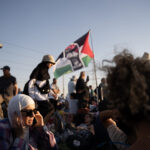For five non-consecutive terms, up until 2022, Leoluca Orlando served as mayor of Palermo, the capital of Sicily. In that time, Orlando put forth a “cosmopolitan vision of local identity” — in other words, that the city had an essence, and that that essence is multicultural.
In “‘Palermo is a mosaic’: cosmopolitan rhetoric in the capital of Sicily,” a recent article in the journal Modern Italy, Sean Wyer writes of Orlando’s message: how he communicated it, why he saw utility in it, how it was received, and the risks “inherent” in insisting that a city has a true nature.
Orlando was hardly the first to embrace this image of Palermo. As Wyer explains, “Sicilians often emphasize the intricate cultural ‘mixity’ of their island, resulting from its history as a locus of invasion, and its long experience of emigration and immigration.” But Orlando, one of Sicily’s most recognizable politicians, amplified the idea. Wyer argues that this fight against intolerance has been linked to another of Orlando’s struggles: that against the mafia.
Wyer was particularly interested in Orlando’s social media posts, and namely his Facebook missives. He has over 85,000 followers on the platform and, since 2012, has posted thousands of times.
Wyer puts forth that Orlando made his case with a combination of past and present: “To construct a vision of Palermitan local identity, Orlando draws connections between periods in Sicilian history and Palermo’s contemporary reality, arguing that these demonstrate characteristics inherent to Palermo and its inhabitants.” Orlando tried to argue that fascism and indeed even the mafia were an “aberration” in the history of Palermo.
“Palermitanizing”
For some of his commentators, using Palermo’s past to justify an openness in the present made sense: One commentator wrote, “Everyone who comes to Palermo ‘Palermitanizes’ themselves, and often the Indians and the Senegalese speak our dialect better than we do.”
Yet, others rejected that such parallels between past practice and present policy existed: As Wyer notes, “One commentator emphasizes that any convivenza in medieval Sicily was short-lived: Frederick II (1198–1250) expelled Sicily’s remaining Muslims to the mainland. It is by no means straightforward, in other words, to determine what lessons, if any, can be learnt from Sicilian history.”
Orlando tried to use rhetorical as well as historical arguments, comparing the city to a “mosaic,” which, as Wyer notes, is an important art form in the city, core to its cultural identity. Again, though he was not the first to use this line, he amplified it: “Each tile makes a distinct and necessary contribution to the whole. The whole, in turn, is not only capable of incorporating contradictions, differences and tensions, but requires contrasts to convey the desired artistic effect: the whole mosaic is greater than the sum of its parts.”
Orlando’s posts were used symbolically (to inspire a kind of ethos in and toward others in Palermo) and practically (to promote concrete political platforms). Wyer asks whether the effect is to put forth an inclusive vision or, alternatively, whether it is self-congratulatory, obscuring actual xenophobia on the island. Perhaps the answer is both. “This identity narrative will continue to be articulated, reshaped and contested over the coming decades,” Wyer writes, “whether or not elected representatives continue to play an active role in promoting it.”




















